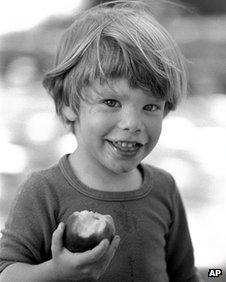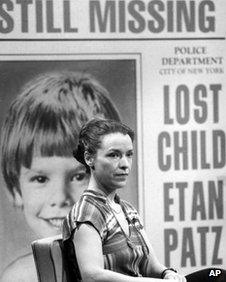Etan Patz, the missing boy who haunted New York
- Published

A man's claim that he had a role in the vanishing of Etan Patz has raised the prospect of a dramatic breakthrough in a landmark missing child case that has haunted New York for decades.
On 25 May 1979, Etan Patz begged his mother Julie to allow him to walk on his own to the bus stop.
And for the first time, she said yes, giving the six-year-old a dollar to buy a soft drink from a shop near the bus.
At the time their neighbourhood of Soho, lower Manhattan, was a place where many residents were on first-name terms with their neighbours, a far cry from the bustling, trendy shopping district of today.
Much of the light industry had departed during America's long manufacturing downturn. Artists, photographers and other bohemians had begun occupying the grand 19th Century buildings, with their spacious, light-filled lofts and cast-iron architecture.
Eight hours lost
When Etan did not get off the bus that afternoon, Julie Patz called his school and was told her son had not turned up that morning.
She called parents of children who took the bus he would have been on; those children said Etan had not been aboard in the morning. Julie rang the police, then her husband at work.
Over the next few weeks, residents and hundreds of police officers fanned out across the neighbourhood; bloodhounds were brought in from out of the city; Soho printers donated fliers with Etan's photograph, printed in English, Spanish, Chinese, Yiddish and Italian.
Eventually, the flurry of interest died down, and the neighbourhood settled back into its rhythms.

Etan's father Stanley Patz and mother Julie live in the same Soho apartment as they did in 1979
Julie and Stan Patz focused on raising their daughter Shira, eight, and Ari, two. But they also began a campaign to patch up the shortcomings in a system they believed had contributed to the failure to find their son.
The couple called for a national fingerprint database, and for federal laws requiring parents to notify their schools when their children are to be absent, and for schools to notify parents if their child does not show up.
''We lost eight hours that way,'' Julie Patz later said.
Because of the parents' efforts, missing children's photographs began appearing on milk cartons - with Etan's face one of the first to feature - shopping bags, buses, and elsewhere.
''If it makes people feel uncomfortable, that's terrific," Mrs Patz told the New York Times in 1985.
The police developed thousands of leads - four filing cabinets full of clues.
As late as 1985, the New York Police Department kept two detectives on the case, along with an FBI agent.
By 1988, the detectives were calling the family - who still live in the same loft flat as on the day Etan vanished - regularly with updates on new leads.
Investigative dead-ends
In 2001, the Patzes obtained a court order declaring Etan dead as part of a lawsuit in which a convicted child molester was held responsible for their son's death.

Etan's mother, Julie Patz, publicises his case on US television in 1981
Jose Antonio Ramos was friends with a woman who worked as a babysitter for Etan around the time of the disappearance.
In 1989, he told police he had picked the boy up from Washington Square Park, a few blocks from Etan's home, and took him to an apartment.
Ramos told police the six-year-old had rebuffed his sexual advances and left, saying he was heading uptown to visit an aunt.
In 1990, Ramos was convicted of child molestation in a separate case and sentenced to a lengthy prison term. Prosecutors had insufficient evidence to charge him in Etan's disappearance.
As part of the Patzes' lawsuit against him, Ramos was ordered by a court to give $2m (£1.3m) to the family, but no money was ever paid. He is scheduled to be released this year.
The case - all but unknown to an entire generation of New Yorkers, but seared into the memories of their elders - re-emerged in the public eye last month.
The FBI and New York police excavated a basement about a block from the Patz home, but said four days later they had found no evidence of human remains. The trail seemed to have gone cold again.
The news that a man has implicated himself in the case raises the tantalising prospect of an answer, at last, to the 33-year-old mystery of what happened to the boy on the milk carton.
- Published25 May 2012
- Published23 April 2012
- Published20 April 2012
- Published20 April 2012